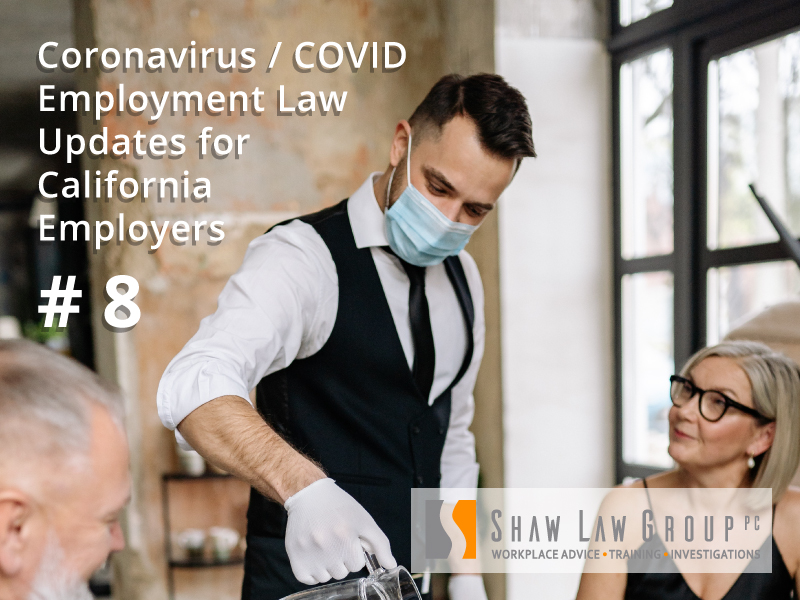Greetings and welcome to our ongoing series of blog posts about Coronavirus / COVID-19 related employment law for California employers.
UPDATE – NEW NOTICE ISSUED 4/27/20 HERE. Employers must post the notice where employees can read it. For those employees working remotely, electronic distribution is permitted.
California Effectively Extends the Federal Paid Sick Leave Benefit to Larger Employers Involved in Certain Food Service Industries and Occupations
California Governor Gavin Newsom issued a new Executive Order – here. This Order effectively extends the federal paid sick leave provisions of the Families First Coronavirus Response Act (FFCRA) to certain “food sector” workers, but at employers > 500 employees. (The FFCRA applies only to employers of under 500 workers). If your business is close to 500, the Order explains how to measure.
The new Order applies only to certain employers – or “hiring entities” and only to certain workers.
- In addition to the size requirement (500 or more employees), the business must be exempt from the “stay at home” executive order No. N-33-20 as an “essential critical infrastructure worker.” This may mean that restaurants ordered to close as “non-essential” will not be covered.
- Only workers who have to work away from home are eligible. So telecommuters do not receive sick leave.
- Only workers defined as “Food Sector Workers” are eligible.
So, first: is your employer the right size? Second, is your business covered as employing “Food Sector Workers”? Third, is your business exempt as “essential” from the stay at home order? And are your workers performing the duties away from home (not telecommuters)?
Types of Operations Covered
The Order covers more than just “employers,” but rather “hiring entities.” It seems as though it is intended to cover the independent contractor type or “gig” relationships in addition to employer-employee jobs.
The Order applies to employees of a “food facility,” as defined in the Health and Safety Code here. That appears to apply to a variety of food service establishments, such as restaurants, cafeterias, commissaries, food service in facilities like nursing homes, and even vending operations. In addition, the new Order applies to employees who deliver food from food facilities, which appears to target workers who work for the food delivery companies like Uber Eats, etc.,
The Order also applies to employees subject to Wage Order 3-2001, 8-2001, 13-2001, and 14-2001:
3-2001 is an industry order applicable to food manufacturing facilities such as
canning soups, or of cooking, canning, curing, freezing, pickling, salting, bottling, preserving, or otherwise processing any fruits or vegetables, seafood, meat, poultry or rabbit product, when the purpose of such processing is the preservation of the product and includes all operations incidental thereto.
8-2001 is applicable to the harvesting industry, i.e., businesses involved in.
grading, sorting, cleaning, drying, cooling, icing, packing, dehydrating, cracking, shelling, candling, separating, slaughtering, picking, plucking, shucking, pasteurizing, fermenting, ripening, molding, or otherwise preparing any agricultural, horticultural, egg, poultry, meat, seafood, rabbit, or dairy product for distribution, and includes all the operations incidental thereto.
13-2001 is the wage order that applies to food processing on farms:
operation performed in a permanently fixed structure or establishment on the farm or on a moving packing plant on the farm for the purpose of preparing agricultural, horticultural, egg, poultry, meat, seafood, rabbit, or dairy products for market when such operations are done on the premises owned or operated by the same employer who produced the products referred to herein and includes all operations incidental thereto.
And 14-2001 applies to occupations involved in agriculture. There’s a long definition of the types of occupations covered, which you can read here in Section 2(D).
Reasons for Leave
- Federal, state, or local quarantine order related to COVID-19.
- A healthcare provider advised the worker to self-quarantine due to COVID-19.
- The hiring entity prohibited the worker from working due to “health concerns related to potential transmission” of the virus.
Interestingly, the Order doesn’t seem to cover actual COVID-19 illness unless one of the three bullets above applies.
Leave Amount and Pay
Covered businesses have to grant up to 80 hours of paid sick leave to eligible full-time workers. For workers less than “full time” (either designated full time or working 40 hours per week), the number of hours is determined via calculations based on the number of hours worked.
Sick Leave under this provision is in addition to any paid sick leave available under existing law (e.g, Labor Code section 246).
The rate of pay for the leave is the higher of the most recent “regular rate of pay,” or state or local minimum wage. There are “caps” on the amount of pay similar to those under the FFCRA (maximum of $511 per day or $5111 total leave benefit).
This new benefit applies while the “stay at home” orders are in effect. However, anyone already on a paid sick leave when the order expires will be entitled to use any remaining leave.
This Order does not apply to employers that provide sick leave benefits that are more generous than the Order provides.
Other
Separate from the new leave rule, the Order contains a requirement that Food Facilities’ hiring entities allow workers to wash hands at least every 30 minutes. (Sure hope they were allowing that before).
This is just a summary of the Order. There are enforcement provisions to review, etc.
There will be a notice required to post and/or distribute to employees, which the Labor Commissioner will have available next week.



 Trending
Trending